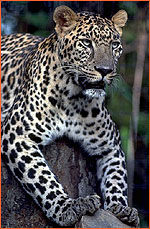 Leopard
LeopardThe leopard is able to hunt in near-lightless conditions thanks to its circular pupil, which is capable of vast dilation. This attribute, in conjunction with a superb sense of smell and a remarkable ability to detect movement, makes the leopard a deadly predator by night. During the day, when the leopard no longer has the edge of nocturnal vision, it uses its eyelids to help its hunting chances. The leopard hunts with slitted eyes not only to protect them but also to make them more difficult for prey to spot.
What's different about the nocturnal eye?
Photo: National Zoological Park, Smithsonian Institution.
Night Vision | Camera that Caught a Leopard
Behind the Scenes | Seeing through Camouflage
Resources | Transcript | Site Map | Leopards Home
Editor's Picks | Previous Sites | Join Us/E-mail | TV/Web Schedule
About NOVA | Teachers | Site Map | Shop | Jobs | Search | To print
PBS Online | NOVA Online | WGBH
© | Updated November 2000